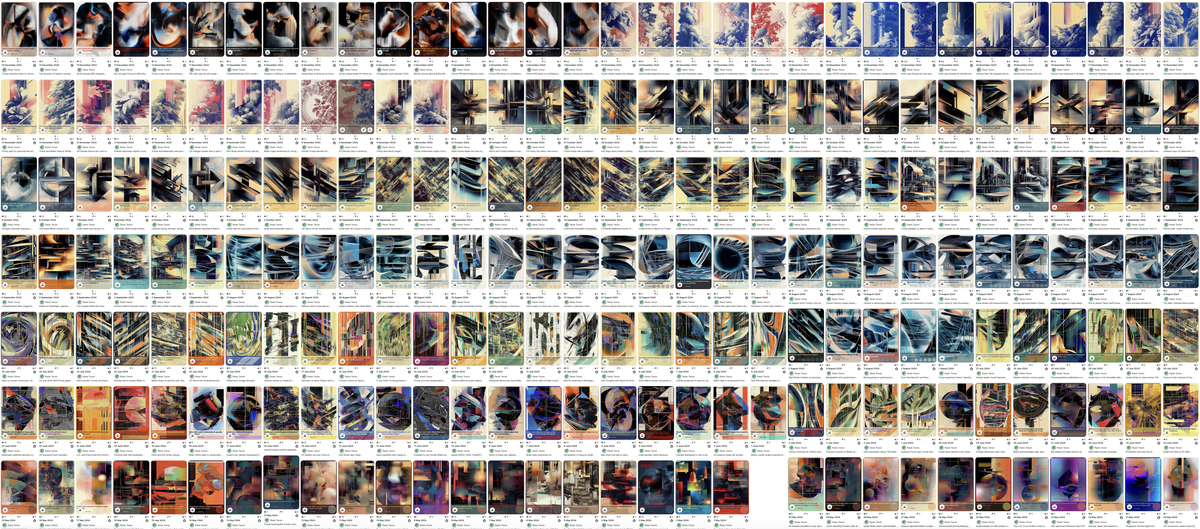
Art as the Timekeeper: The Polemics of Present's Edge
written by PaoloTonon
What happens when the raw materials of art are pulled directly from the headlines? This is a question I wrestle with daily as I create Present's Edge. For nine months, I’ve been walking a tightrope, balancing abstract beauty with the harsh realities of global events. I knew from the start this approach would provoke discomfort—how could it not? But discomfort, I believe, is where the power of art lies.
Rooted in the tradition of the readymade, my work takes its titles from the most resonant news stories in the Western world. Much like Duchamp’s urinal, I don't transform these titles; I transplant them, pairing them with abstract compositions generated in MidJourney. The result is a body of work that doesn’t editorialize or celebrate but anchors itself to the historical moment of its creation. These pieces aren’t just art—they’re timestamps.
I use MidJourney’s "Blend" feature, which means I don’t write prompts. Instead, I combine previous images, creating a kind of genetic evolution. If you look closely, some pieces carry the faint imprint of their source material: a silhouette, a fragment of a cityscape, a hint of a battlefield. This iterative process mirrors the way the news itself operates, with stories resurfacing, mutating, and persisting.
The Pushback: Beauty Meets Brutality
I’ve heard the feedback—both directly and in comments. “Your pieces are beautiful, but the titles disturb me.” “I turn to art to escape the news, not relive it.” I get it. People want art to be a sanctuary, a reprieve from the endless churn of daily life. But for me, there’s no such thing as an art that exists apart from its time.
That’s the core of Present’s Edge: abstraction isn’t a void. It’s always shaped by the world around it. To ignore that would be to indulge in a kind of false neutrality. Artists like the Russian Constructivists or Hannah Höch understood this—every piece, no matter how abstract, carries the DNA of its socio-political context.
At the same time, I aim for aesthetic consistency to ground the chaos. Each month has its own theme: August was inspired by the “deep summer sea,” while November reflected the Staffordshire porcelain aesthetic in red and blue. These visual anchors provide continuity, even when the subject matter is anything but.
The Message Behind the Work
For me, the titles aren’t just labels—they’re anchors. They tether each piece to its time, reminding us that art, like life, is never created in a vacuum. Some viewers have told me they feel trapped between the abstraction of the images and the weight of the headlines, as if the two elements pull them in opposite directions. That tension is intentional.
I don’t think we can escape the world we live in, no matter how much we want to. Whether we engage with the news or not, it shapes our lives—and our art. Present’s Edge is my way of making that visible. The works don’t celebrate the news; they respond to it. They’re children of their time, just like the rest of us.
Looking Ahead
Nine months in, I find myself reflecting on where this project should go. War has been a constant theme, whether in Ukraine, Gaza, or now with escalating conflicts in the Middle East. It’s exhausting, but that’s the reality of the world we live in. Can I evolve the project without losing its essence?
I think so. The same iterative process that drives the art can drive the concept itself. Perhaps it’s time to invite more direct interaction with the audience or to explore narrative layers that connect the works more explicitly.
But one thing won’t change: Present’s Edge isn’t about comfort. It’s about tension—the friction between beauty and brutality, abstraction and reality. That friction is what keeps it alive for me. Some people might find it too much, and that’s okay. Art, like life, isn’t here to make us comfortable. It’s here to make us think.
And that’s why I keep going—because, like the stories that inspire these works, I can’t look away.
On my site you can find information and references of the Present's Edge project.
Thanks for reading and collecting the article.